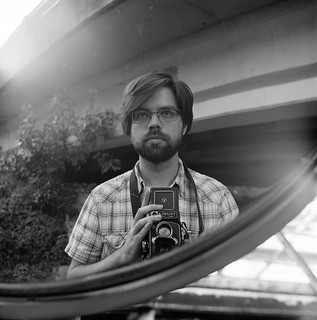
Shoot, Damn It
I really wasn't sure what to shoot this week, but I decided I'd go out and shoot something anyway. One of the primary goals in starting this blog was to keep myself accountable; to kick my ass into going out and shooting something every week. I've heard the advice that writers get, that you should write every day regardless of whether or not you want to. Like exercise, it's supposed to make you better through sheer experience and repetition. I am trying to do the same thing (though not every day, it takes me long enough to develop and scan film as it is).So, on Thursday June 21st, I grabbed my Yashica Mat 124 twin lens reflex and a roll of film before heading out to work. I told myself that I would go and shoot SOMETHING after work. And while I don't think that what I shot was remarkable artistically, I am proud of the fact that I went out and did it. I tried to practice my visualization, not just to take pictures of anything and everything but to try and find the interesting shots available to me.
I'm pretty sure I did a crappy job at that, but you have to start somewhere. I think that every roll of film I put through a camera while being thoughtful about it, even if nothing is clicking that day, is good exercise.
Even though I don't think the pictures are that interesting, though, there are two interesting things I want to talk about with this roll.
Sunny 16
My Yashica Mat has a light meter built in to it, but it's busted and unreliable. I don't even look at it. This has, in the past, kept me from going out with this camera, which is a shame. It's fun to use and it's no heavier than any of my film SLRs.I recently decided that I needed to develop (get it, it's a photography blog) the ability to guesstimate my exposures without relying on a light meter. So I started practicing using the Sunny 16 Rule.
The fact that every frame of film I shot this week has an image on it means that I did pretty well. Most of them seem exposed correctly, too, so I seem to have been more or less on the money. Black and white film is pretty flexible, though, so I would still use a light meter if I was doing anything in color, or anything very important.
Still though, being able to go outside with a mechanical camera and say "I'm thinking I need to shoot this at f/4 and 1/125th" is freeing. It gives you a little more confidence not to have to rely on another device.
Plus-X
The other thing I want to talk about is the fact that I shot this on my second-to-last roll of Kodak Plus-X, which has been discontinued. This particular batch expired in January 2009. The one roll I have left will almost certainly be the last roll I ever get to shoot.Plus-X is the slower version of Tri-X, meaning it has finer grain but requires a lot more light. Tri-X has been my film of choice for forever. It's very forgiving--you can shoot it in almost any situation and you can quite frankly abuse it and you still get pictures. It's kind of an easy film to learn on in that regard. It's grainy and old-fashioned looking, but I don't mind. It's kind of like the black coffee of film.
Plus-X, on the other hand, never interested me. If I wanted something with less grain, I'd get one of the fancier slow-speed films. The benefit of Tri-X is its versatility, which Plus-X didn't offer to the same degree. I'm sure many people loved the film, and it's been around forever, so I'm not knocking it, but its discontinuance didn't bother me too much.
But all the same, it was kind of an icon. Sure, it was overshadowed by its faster, more versatile brother, but you always knew it was there. And now it's not.
 |
| You'd think I'd have corrected that framing. |
I don't think black and white film is going away. Kodak aren't the only players in the game: Ilford in England only makes black and white film and is a smaller, nimbler company that can tolerate smaller profit margins. Fujifilm is so diversified, and makes so much money, that they seem to put out old-fashioned products just to satisfy their own whims. And like I said, I never really shot this film.
But all the same, it's a sobering sign of the times. I have one more roll, and I hope I do it justice. Happy trails, Plus-X.



